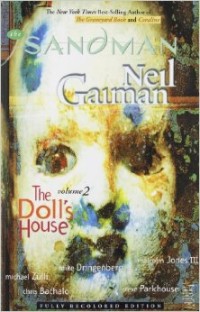Early summer reads: short reviews
I shouldn’t complain that life has been full of holidays and social events and lovely weather to be enjoyed (and work), and to be honest it hasn’t slowed down my reading particularly. But it does mean I am woefully behind on reviews, so here are some brief thoughts on recent reads.
 The Sandman Vol. 2 The Doll’s House
The Sandman Vol. 2 The Doll’s House
by Neil Gaiman, Mike Dringenberg and Malcolm Jones III
How to explain The Sandman? It’s a whole mythology where Death and Dream and Desire and several others are immortal non-human siblings, sharing or sometimes squabbling over their power/responsibility. This review contains some minor spoilers of the first volume.
Dream, or Morpheus, has recently awoken from his entrapment by a magicians’ circle to find the Dreaming in chaos. While setting it all to rights, he senses that there is a Dream Vortex in the shape of a young woman, Rose Walker. She is trying to put her family back together, unaware of the danger that surrounds her or of Dream trailing her closely. Rose is a fantastic character and there are some wonderful comic touches here, such as the serial killers’ convention. But really it’s the combination of gorgeous art (with wonderful covers by long-time Gaiman collaborator Dave McKean) and writing that make this a great book.
“It seemed like the late autumn wind blew them in that night, spinning and dizzying from the four corners of the world. It was a bitch wind, knife-sharp and cutting, and it blew bad and cold. And they came with it, scurrying and skittering, like yellow leaves and old newspapers, from a thousand places and from nowhere at all. They came in their suits and their tee shirts, carrying rucksacks and suitcases and plastic bags, muttering and humming and silent as the night.”
First published as The Sandman issues 9–16 by DC Comics in 1990.
This collected edition published 2010 by DC Comics.
Source: Excelsior Comics, Bristol.
 Don’t Try This at Home
Don’t Try This at Home
by Angela Readman
This collection of short stories is wonderfully skewed, with a touch of the macabre, while still being grounded in real life. They’re quiet but colourful. The opening and title story of the collection is about a woman who repeatedly chops her boyfriend in half, multiplying him so that he can work and be with her, but more is never enough. Or is it too much? “Conceptual” describes a family who have taken conceptual art to an extreme, applying it to every part of their life. In “Boys like dolls”, a GI Joe toy talks to its young owner, confirming his fears and prejudices. They are brilliantly twisted tales, with a definite air of fairy-tale macabre.
“The witch came in without wiping her feet. I sat on the mat, inching behind the chair. The woman’s skin was dried meat, withered. The top of her spine was a question mark.
‘Is this the child?’ She squinted at me the way women at the market squeeze peaches.”
Published 2015 by And Other Stories.
Source: I subscribe to the publisher.
 Forever
Forever
by Judy Blume
This is one of those teen classics that I’ve always heard talked about in hushed admiration but had somehow not got round to reading before now. I completely get its legendary status, even though I don’t think it’s the bees knees myself. It’s the story of 17-year-old Katherine embarking on her first serious relationship, with Michael. Judy Blume perfectly captures the intensity, naivety and insularity of teen love. What is more unusual is the way she treats teen sex: with matter-of-fact honesty, raising the issues surrounding it without ever making this feel like a textbook in disguise. As I remember from my childhood, Blume writes great fun characters with interesting quirks who all feel immediately real. But what I had forgotten (or perhaps is different in this book from Blume’s others?) is that the prose itself is nothing special and the storyline wholly predictable. I guess those things matter less when you’re 13 or 14.
“Sybil Davison has a genius IQ and has been laid by at least six different guys. She told me herself, the last time she was visiting her cousin, Erica, who is my good friend. Erica says this is because of Sybil’s fat problem and her need to feel loved – the getting laid part, that is. The genius IQ is just luck or genes or something.”
First published 1975. Reissued with an author introduction 2003 by Simon & Schuster.
Source: Strand Bookstore, New York